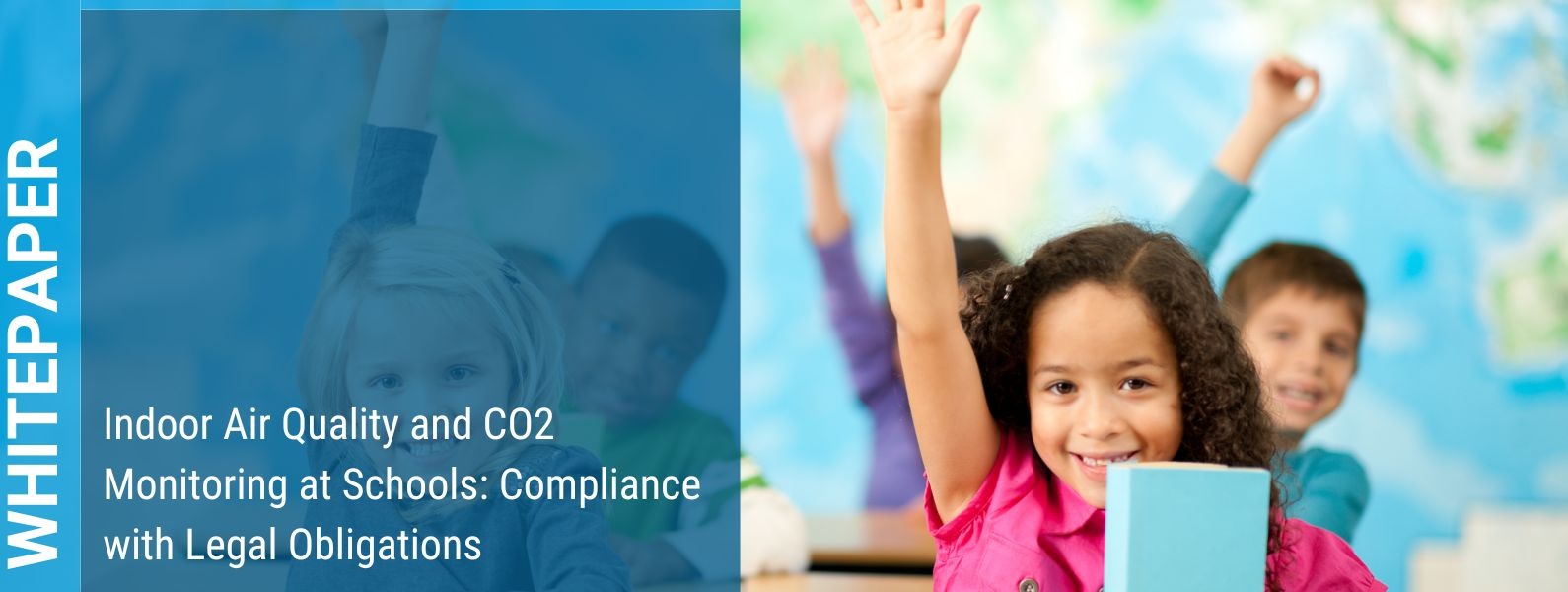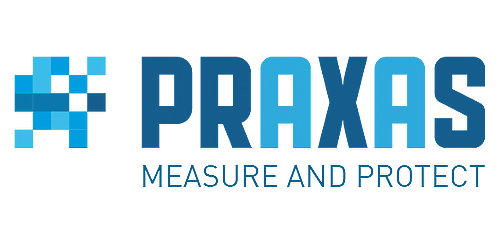Indoor Air Quality and CO2 Monitoring at Schools: Compliance with Legal Obligations
- Posted on
- By Praxas
- Posted in AirQuality, CO2Monitoring, Education, HealthyEnvironments, Schools
- 0

Explore the vital role of CO2 monitoring in ensuring healthy indoor air quality in schools, meeting Dutch regulations. From legal obligations to practical implementation, this paper guides schools, emphasizing awareness, strategic monitoring, expert collaboration, and continuous adaptation. Together, let's create optimal learning environments.
I. Introduction
Background information
The quality of the indoor air in which we live, work and learn has a significant impact on our health and well-being. Especially in educational environments such as schools, it is vital to closely monitor indoor air quality. This whitepaper provides in-depth insights into the different aspects of indoor air quality, with special emphasis on the role of CO2 and the need for effective monitoring, according to the specific legal obligations in the Netherlands.
Importance of Indoor Air Quality in Schools
Schools are the foundation of knowledge transfer and growth for young minds. Healthy indoor air quality is essential for both the physical health and learning performance of students and the well-being of teaching staff. This chapter explores in depth why indoor air quality is critical in schools and how it directly impacts both physical health and student learning.
Purpose of the Whitepaper
The main aim of this white paper is to provide clarity on the importance of healthy indoor air quality in educational environments, with a specific emphasis on schools. The coming chapters will look in depth at various aspects of indoor air quality, including the role of CO2 monitoring as a crucial indicator. The main objectives of this whitepaper are as follows:
- Raising Awareness: One of the main objectives of this white paper is to raise awareness of the impact of indoor air quality on the health, well-being and learning performance of both students and teachers. By providing insight into the interrelationship of air quality with the learning process, we hope to sensitize schools to this important aspect of educational environments.
- Informing about Legal Obligations: This whitepaper provides detailed information about international and national legal requirements regarding indoor air quality in schools. By providing insight into the specific standards and guidelines that schools must follow, we aim to inform schools of their legal responsibilities.
- Provide Technical Guidance: Another important goal is to provide technical guidance regarding CO2 monitoring. We will discuss suitable CO2 monitors, including their features, installation procedures and calibration requirements. This equips schools with the necessary knowledge to implement effective monitoring solutions.
- Encouraging Proactive Measures: Finally, this whitepaper aims to encourage schools to take proactive measures to improve indoor air quality. By sharing best practices and highlighting how accurate CO2 monitoring can lead to better learning conditions, we hope to inspire schools to take action for a healthier and more productive learning environment.
In the following chapters we will delve deeper into the legal obligations regarding CO2 monitoring in schools, the technical requirements for effective implementation, and the strategies and best practices that schools can implement to ensure healthy indoor air quality. The goal is to provide a clear path for schools to not only meet standards, but also create a nurturing and healthy environment in which students thrive and reach their full potential.
II. Legal Obligations for CO2 Monitoring
International Laws and Regulations
Globally, indoor air quality is recognized as an important aspect of people's health and well-being. Various international organizations and agreements have issued guidelines and recommendations regarding air quality and CO2 levels in enclosed spaces.
An example of this is the World Health Organization (WHO), which has established air quality guidelines covering various pollutants, including CO2. Although these guidelines are not legally binding, they serve as a reference point for many countries in formulating their own standards and regulations.
Specific Legislation for Schools in the Netherlands
In the Netherlands there is specific legislation and regulations that apply to indoor air quality in schools. The Dutch government has recognized that good air quality in schools is essential for the well-being and performance of students and teachers.
An important legislation regarding CO2 monitoring in schools is the Arbowet (Working Conditions Act) and the associated Arbobesluit. These laws provide guidelines for working conditions, including indoor air quality, in workplaces, including schools. This states, among other things, that employers are obliged to guarantee air quality and, if necessary, take measures to improve it.
In addition, the Netherlands has established specific rules for air quality in schools, as laid down in the Building Decree. This decision sets requirements for the minimum ventilation capacity in classrooms and other school spaces to ensure healthy indoor air quality.
Role of CO2 Monitoring in Compliance with Standards
CO2 monitoring plays a crucial role in meeting legal standards and regulations regarding indoor air quality. CO2 is an excellent indicator of ventilation efficiency and air circulation in a room. Too high a concentration of CO2 often indicates insufficient ventilation, which can lead to poor air quality and health problems.
By regularly monitoring CO2 levels, schools can evaluate the effectiveness of their ventilation systems and ensure they meet set standards. Furthermore, with the help of CO2 monitors, schools can quickly respond to any problems and take proactive measures to improve indoor air quality and meet legal obligations.
III. CO2 Monitor Requirements and Implementation
Criteria for Suitable CO2 Monitors
When selecting CO2 monitors for schools, there are several important criteria to consider:
- Accuracy: The monitor must be able to provide accurate measurements of CO2 levels to collect reliable data for evaluation.
- Measuring range: The monitor should have a wide measuring range to detect both normal and potentially dangerous CO2 levels.
- Speed of Response: Fast response time is essential to record real-time changes in CO2 levels.
- Reliability: The monitor must be reliable so that schools can trust that the data collected is accurate.
- Data Logging Feature: A data logging feature allows schools to retain historical data for analysis and reporting.
- Easy Integration: The monitor must be easy to integrate into existing ventilation systems or data recording networks.
Installation Procedures in Schools
When installing CO2 monitors in schools, it is very important to choose strategic locations where the air quality is most representative of the entire space. This includes locations near air vents, away from doors, windows and other direct sources of CO2 emissions. Monitors should be placed at eye level, but not too close to people so as not to affect their breathing.
Benefits of Calibrated Monitors
Calibrated CO2 monitors are essential for accurate measurements. Calibration ensures that the monitor delivers consistently reliable results. A calibrated monitor offers schools the assurance that the measured CO2 levels are accurate, allowing them to respond more quickly and effectively to any air quality problems.
Role of Praxas and Lascar in Implementation
Companies such as Praxas and Lascar play a crucial role in the implementation of CO2 monitors in school environments. Praxas offers expertise in logistics solutions, including the safe transport of sensitive measuring equipment. Lascar, with its expertise in data logging technology, offers advanced CO2 monitors and support in implementing these systems in schools.
By working with specialist companies such as Praxas and Lascar, schools can not only obtain reliable CO2 monitors, but also professional guidance and support in implementation, which is essential to comply with legal obligations and ensure a healthy learning environment.
IV. Methods of CO2 Monitoring
Placement of Monitors in Classrooms and Common Areas
When placing CO2 monitors in classrooms and common areas, it is important to choose strategic locations. Monitors should be installed in locations where the air quality is representative of the entire space. They should be placed at eye level, but not too close to windows, doors or ventilation systems, so as not to influence the measurements.
It is also essential to place monitors in common areas such as libraries, cafeterias and gymnasiums, as these areas often have higher occupancy rates. By choosing the right locations, schools can collect reliable data on air quality where students and staff spend the most time.
Timetable for Measurements
A regular schedule for CO2 measurements is necessary to detect changes in indoor air quality. It is recommended to take measurements at fixed times throughout the school day. Starting at the start of the school day, at intervals throughout the day, provides a holistic view of air quality and helps identify patterns that may otherwise be overlooked.
Registration and Analysis of Data
Accurately recording and analyzing collected data is just as important as the measurements themselves. Schools must keep a detailed log of CO2 levels and other relevant environmental variables such as temperature and humidity. By analyzing this data regularly, schools can identify trends and quickly identify any problems.
Use of Datalogging Technology
Data logging technology plays a key role in collecting and storing air quality data. Modern CO2 monitors, such as those offered by Lascar, are equipped with data logging functions. These monitors store data automatically and can often connect wirelessly to a cloud service for real-time monitoring. This makes it possible for schools to not only retain historical data, but also monitor air quality in real-time, even remotely.
By following these practices, schools can not only meet legal obligations but also ensure a healthy and stimulating learning environment for their students and staff. The appropriate use of CO2 monitors, combined with consistent data recording and analysis, contributes to improved indoor air quality and promotes the overall well-being of the school community.
IV. Methods of CO2 Monitoring
Placement of Monitors in Classrooms and Common Areas
When placing CO2 monitors in classrooms and common areas, it is important to choose strategic locations. Monitors should be installed in locations where the air quality is representative of the entire space. They should be placed at eye level, but not too close to windows, doors or ventilation systems, so as not to influence the measurements.
It is also essential to place monitors in common areas such as libraries, cafeterias and gymnasiums, as these areas often have higher occupancy rates. By choosing the right locations, schools can collect reliable data on air quality where students and staff spend the most time.
Timetable for Measurements
A regular schedule for CO2 measurements is necessary to detect changes in indoor air quality. It is recommended to take measurements at fixed times throughout the school day. Starting at the start of the school day, at intervals throughout the day, provides a holistic view of air quality and helps identify patterns that may otherwise be overlooked.
Registration and Analysis of Data
Accurately recording and analyzing collected data is just as important as the measurements themselves. Schools must keep a detailed log of CO2 levels and other relevant environmental variables such as temperature and humidity. By analyzing this data regularly, schools can identify trends and quickly identify any problems.
Use of Datalogging Technology
Data logging technology plays a key role in collecting and storing air quality data. Modern CO2 monitors, such as those offered by Lascar, are equipped with data logging functions. These monitors store data automatically and can often connect wirelessly to a cloud service for real-time monitoring. This makes it possible for schools to not only retain historical data, but also monitor air quality in real-time, even remotely.
By following these practices, schools can not only meet legal obligations but also ensure a healthy and stimulating learning environment for their students and staff. The appropriate use of CO2 monitors, combined with consistent data recording and analysis, contributes to improved indoor air quality and promotes the overall well-being of the school community.
V. Actions to Reduce CO2 Levels
Strategies for Improved Ventilation
An effective strategy to reduce CO2 levels is to improve ventilation in school buildings. This can be achieved by promoting natural ventilation, such as regularly opening windows and doors to let in fresh air. Mechanical ventilation systems can also be adjusted to ventilate more often and more efficiently. It is important that schools ensure that ventilation systems are regularly maintained and cleaned to ensure optimal performance.
Role of Technology Solutions
Technological solutions are playing an increasingly important role in maintaining healthy indoor air quality. Air purifiers with advanced filters can help remove pollutants, including CO2, from the air. In addition, smart ventilation systems can be implemented, which automatically respond to fluctuations in CO2 levels and adjust ventilation accordingly.
Awareness and Training of Students and Staff
It is very important to make both students and staff aware of the importance of good ventilation and the impact of CO2 on their health and performance. Schools can organize educational programs to raise awareness and share guidance on how students and staff can contribute to better air quality, for example by keeping windows open and being aware of activities that increase CO2 production.
Continuous Monitoring and Adjustments
While implementing improved ventilation strategies and technology solutions is crucial, it is equally important to continuously monitor air quality. By regularly analyzing the data from CO2 monitors, schools can recognize patterns and make adjustments where necessary. For example, if certain areas exhibit consistently high CO2 levels, additional measures can be taken, such as increasing ventilation capacity in those specific areas.
By combining and adapting these actions to the specific needs of their school buildings, schools can not only meet legal obligations, but also create a healthy and comfortable learning environment in which students and staff can thrive. Constantly striving for improvement and adapting strategies based on evolving insights are essential to maintain a high level of indoor air quality.
VI. Conclusion
Summary of Key Points
In this white paper we have highlighted the crucial role of CO2 monitoring in schools. We started by discussing the legal obligations, paying attention to international standards and specific Dutch regulations. We then covered the criteria for suitable CO2 monitors, installation procedures, benefits of calibrated monitors and the role of companies such as Praxas and Lascar.
We analyzed methods in CO2 monitoring, including strategies for monitor placement, measurement timings, data recording and analysis, and the use of data logging technology. Furthermore, we discussed how schools can reduce CO2 levels, focusing on improved ventilation, technology solutions, awareness and training, as well as continuous monitoring and adjustments.
Call to Action for Schools
In conclusion, we make a strong call to action for schools in the Netherlands. Ensuring healthy indoor air quality is a shared responsibility of schools, teachers, students and parents. Schools are encouraged to:
- Raise awareness: Make parents, students and staff aware of the importance of good air quality and their role in maintaining it.
- Implement regular monitoring: Regularly monitor CO2 levels and other air quality parameters to identify potential problems in a timely manner.
- Collaborate with experts: Collaborate with specialist companies such as Praxas and Lascar to receive expert advice and implement high-quality CO2 monitors.
- Develop educational programs: Develop educational programs that make students aware of the importance of air quality and how they can contribute to a healthy learning environment.
- Stay flexible: Constantly adapting strategies based on evolving insights and technological advances to always ensure the best air quality.
Through joint efforts, schools can not only meet legal obligations, but also create a stimulating and healthy environment in which students can grow, learn and thrive. Together, let's build a future where every student can thrive in an environment with clean, fresh air.
For PDF click here


Comments
Be the first to comment...